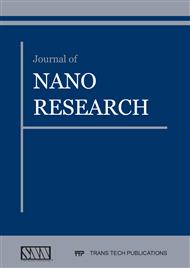[1]
A. Loni, L. T. Canham, M. G. Berger, R. Arens-Fischer, H. Munder, H. Luth. H. Arrand, and T. M. Benson, Porous silicon multilayer optical waveguides, Thin Solid Films 276, 143–146 (1996).
DOI: 10.1016/0040-6090(95)08075-9
Google Scholar
[2]
V. Mulloni and L. Pavesi, Porous silicon microcavities as optical chemical sensors,, Appl. Phys. Lett. 76, 18, 2523 - 2525 (2000).
DOI: 10.1063/1.126396
Google Scholar
[3]
E. Osorio, R. Urteaga, H. Juárez, and R.R. Koropecki, Transmittance correlation of porous silicon multilayers used as a chemical sensor platform,, Sens. Actuators B. 213, 164-170 (2015).
DOI: 10.1016/j.snb.2015.02.058
Google Scholar
[4]
L.N. Acquaroli, R. Urteaga, and R.R. Koropecki, Innovative design for optical porous silicon gas sensor,, Sens. Actuators B. 149, 189-193 (2010).
DOI: 10.1016/j.snb.2010.05.065
Google Scholar
[5]
I. A. Levitsky, Porous Silicon Structures as Optical Gas Sensors,, Sensors 15, 19968-19991 (2015).
DOI: 10.3390/s150819968
Google Scholar
[6]
F. A. Harraz, Porous silicon chemical sensors and biosensors: A review,, Sens. Actuators B. 202, 897–912 (2014).
DOI: 10.1016/j.snb.2014.06.048
Google Scholar
[7]
J. F. Borrull, J. Pallarès, G. Macías, L. F. Marsal, Nanostructural Engineering of Nanoporous Anodic Alumina for Biosensing Applications,, Materials 7, 5225-5253 (2014).
DOI: 10.3390/ma7075225
Google Scholar
[8]
Y. Wang, Y. Chen, T. Kumeria, F. Ding, A. Evdokiou, D. Losic, and A. Santos, Facile Synthesis of Optical Microcavities by a Rationally Designed Anodization Approach: Tailoring Photonic Signals by Nanopore Structure,, ACS Appl. Mater. Interfaces 7, 9879-9888 (2015).
DOI: 10.1021/acsami.5b01885
Google Scholar
[9]
K. I. Hartmann, A. Nieto, E. C. Wu, W. R. Freeman, J. S. Kim, J. Chhablani, M. J. Sailor, and L. Cheng, J. Ocul. Hydrosilylated Porous Silicon Particles Function as an Intravitreal Drug Delivery System for Daunorubicin,, Pharmacol. Ther. 29, 5, 493-500 (2013).
DOI: 10.1089/jop.2012.0205
Google Scholar
[10]
O.Bisi, Stefano Ossicini and L.Pavesi, Porous silicon: a quantum sponge structure for silicon based optoelectronics,, Surf. Sci. Rep. 38, 1-126 (2000).
DOI: 10.1016/s0167-5729(99)00012-6
Google Scholar
[11]
M. H. Chan, S. K. So, and K. W. Cheah, Optical absorption of free-standing porous silicon films,, J. Appl. Phys 79, 6, 3273-3275 (1996).
DOI: 10.1063/1.361216
Google Scholar
[12]
V. Grivickas and P. Basmaji, Optical absorption in porous silicon of high porosity,, Thin Solid Films 235, 234-238 (1993).
DOI: 10.1016/0040-6090(93)90271-p
Google Scholar
[13]
L. Pavesi, Porous silicon dielectric multilayers and microcavities,, L. Riv. Nuovo Cim 20, 10, 1-76 (1997).
DOI: 10.1007/bf02877374
Google Scholar
[14]
D. W. Thompson, P. G. Snyder, L. Castro, L. Yan and P. Kaipa, Optical characterization of porous alumina from vacuum ultraviolet to midinfrared,. J. Appl. Phys. 97, 113511-1-113511-9 (2005).
DOI: 10.1063/1.1921336
Google Scholar
[15]
A. Santos J. Mater. Nanoporous anodic alumina photonic crystals: fundamentals, developments and perspectives,, Chem. C 5, 5581—5599 (2017).
DOI: 10.1039/c6tc05555a
Google Scholar
[16]
C. S. Law, S. Y. Lim and A. Santos, Fine tuning of transmission features in nanoporous anodic alumina distributed Bragg reflectors,, Proc. SPIE 10456, Nanophotonics Australasia (2017).
DOI: 10.1117/12.2282250
Google Scholar
[17]
J. G. J. Peelen and R. Metselaar, Light scattering by pores in polycrystalline materials: Transmission properties of alumina,, J. Appl. Phys 45, 216-220 (1974).
DOI: 10.1063/1.1662961
Google Scholar
[18]
R. Apetz and M. P. B. van Bruggen, Transparent Alumina: A Light-Scattering Model,, J. Am. Ceram. Soc., 86, 480–486 (2003).
DOI: 10.1111/j.1151-2916.2003.tb03325.x
Google Scholar
[19]
P. J. Reece, G. Lérondel, W. H. Zheng, and M. Gal, Optical microcavities with subnanometer linewidths based on porous silicon,, Appl. Phys. Lett. 81, 4895-4897 (2002).
DOI: 10.1063/1.1531226
Google Scholar
[20]
M. Ghulinyan, C. J. Oton, G. Bonetti, Z. Gaburro, and L. Pavesi, Free-standing porous silicon single and multiple optical cavities,, J. Appl. Phys 93, 9724-9729 (2003).
DOI: 10.1063/1.1578170
Google Scholar
[21]
C. S. Law, S. Y. Lim, R. M. Macalincag, A. D. Abell, and A. Santos, Light-Confining Nanoporous Anodic Alumina Microcavities by Apodized Stepwise Pulse Anodization,, ACS Appl. Nano Mater 1, 9, 4418-4434 (2018).
DOI: 10.1021/acsanm.8b00494
Google Scholar
[22]
F. Pedrotti, Introduction to Optics (Prentice-Hall, Inc., 1993).
Google Scholar
[23]
L. Cencha, C. A. Hernández, L. Forzani, R. Urteaga And R.R. Koropecki, Optical performance of hybrid porous silicon–porous alumina multilayers,, J. Appl. Phys 123, 183101-1-183101-8 (2018).
DOI: 10.1063/1.5027073
Google Scholar
[24]
C. K. Y. Ng and A. H. W. Ngan, Precise Control of Nanohoneycomb Ordering over Anodic Aluminum Oxide of Square Centimeter Areas,, Chem. Mater 23 (23), 5264-5268 (2011).
DOI: 10.1021/cm202461z
Google Scholar
[25]
W.Theiß, Optical properties of porous silicon,,Surf. Sci. Rep. 29, 3-4, 91-192, (1997).
Google Scholar
[26]
H. Sohn, Refractive Index of Porous Silicon,, Handbook of Porous Silicon, 1-12 (2014).
DOI: 10.1007/978-3-319-04508-5_25-1
Google Scholar
[27]
Masuda H and Fukuda K. Ofdered Metal Nanohole Arrays Made by a Two-Step Replication of Honeycomb Structures of Anodic Alumina,, Science 268, 1466–1468 (1995).
DOI: 10.1126/science.268.5216.1466
Google Scholar
[28]
H. R. R. Ashtiani and P Karami, Prediction of the Microstructural Variations of Cold-Worked Pure Aluminum during Annealing Process,, Modeling and Numerical Simulation of Material Science, 5, 1-14, (2015).
DOI: 10.4236/mnsms.2015.51001
Google Scholar
[29]
D. F. Li, D. Z. Zhang, S. D. Liu, Z. J. Shan, X. M. Zhang, Q. Wang, and S. Q. Han, Dynamic recrystallization behavior of 7085 aluminum alloy during hot deformation,, Trans. Nonferrous Met. Soc. China 26, 6,1491−1497, (2016).
DOI: 10.1016/s1003-6326(16)64254-1
Google Scholar
[30]
M. J. Sailor, Porous Silicon in Practice; Preparation, Characterization and Applications,, Wiley-VCH, ©2012, pp.133-187.
Google Scholar
[31]
F. Li, L. Zhang, and R. M. Metzger, On the Growth of Highly Ordered Pores in Anodized Aluminum Oxide,, Chem. Mater., 10, 9,2470–2480 (1998).
DOI: 10.1021/cm980163a
Google Scholar


